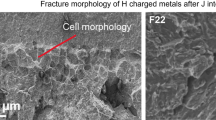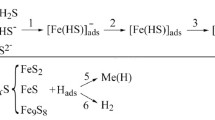It is shown that the procedure of preliminary cyclic hydrogenation-dehydrogenation of ferrite-pearlite pipe steel strongly affects its ability to absorb electrochemical hydrogen whose amount increases with the number of these cycles. The concentration of hydrogen adsorbed by the subsurface layers of the metal, the concentration of hydrogen absorbed by the volume of the metal, and its total concentration in the metal are found depending on the number of hydrogenation-dehydrogenation cycles. It is established that, for the analyzed cases, the procedure of preliminary hydrogenation-dehydrogenation increases the ability of steel to absorb hydrogen by a factor of 1.2–2.









Similar content being viewed by others
References
H. Nykyforchyn, In-service degradation of pipeline steels, in: G. Bolzon, G. Gabetta, and H. Nykyforchyn (editors), Degradation Assessment and Failure Prevention of Pipeline Systems,” Series: Lecture Notes in Civil Engineering, Vol. 102, Springer (2021), pp. 15–29.
L. Nyrkova, S. Osadchuk, S. Melnichuk, A. Rybakov, S. Ostapyuk, and Yu. Borysenko, “Influence of electrochemical destruction products of protective coating on properties of pipe steel in neutral medium,” Mater. Today: Proc., 6, No. 2, 278–287 (2019).
L. Nyrkova, “Stress-corrosion cracking of pipe steel under complex influence of factors,” Eng. Fail. Anal., 116, 104757 (2020).
M. C. Li and Y. F. Cheng, “Mechanistic investigation of hydrogen enhanced anodic dissolution of X-70 pipe steel and its implication on near-neutral pH SCC of pipelines,” Electrochim. Acta, 52, 8111–8117 (2007).
Y. F. Cheng and L. Niu, “Mechanism for hydrogen evolution reaction on pipeline steel in near-neutral pH solution,” Electrochem. Comm., 9, 558–562 (2007).
Y. F. Cheng, “Fundamentals of hydrogen evolution reaction and its implications on near-neutral pH stress corrosion cracking of pipelines,” Electrochim. Acta, 52, 2661–2667 (2007).
O. Y. Andreikiv, I. Y. Dolins’ka, I. P. Shtoiko, O. K. Raiter, and Yu. Ya. Matviiv, “Evaluation of the residual service life of main pipelines with regard for the action of media and degradation of materials,” Fiz.-Khim. Mekh. Mater., 54, No. 5, 33–39 (2018); English translation: Mater. Sci., 54, No. 5, 638–646 (2019).
I. M. Dmytrakh, A. М. Syrotyuk, and R. L. Leshchak, “Specific features of the deformation and fracture of low-alloy steels in hydrogen-containing media: influence of hydrogen concentration in the metal,” Fiz.-Khim. Mekh. Mater., 54, No. 3, 7–18 (2018); English translation: Mater. Sci., 54, No. 3, 295–308 (2018).
L. I. Nyrkova, “Corrosion cracking of Kh70 pipe steel under the conditions of cathodic protection,” Fiz.-Khim. Mekh. Mater., 56, No. 2, 124–129 (2020); English translation: Mater. Sci., 56, No. 2, 273–278 (2020).
А. М. Syrotyuk, R. L. Leshchak, and М. І. Dorosh, “Experimental and analytic investigation of the hydrogenation of pipe steels,” Fiz.-Khim. Mekh. Mater., 53, No. 6, 62–67 (2017); English translation: Mater. Sci., 53, No. 6, 811–817 (2018).
S. A. Shipilov and I. L. May, “Structural integrity of aging buried pipelines having cathodic protection,” Eng. Fail. Anal., 13, No. 7, 1159–1176 (2006).
S. O. Osadchuk, L. I. Nyrkova, A. O. Rybakov, and S. L. Melnychuk, “Influence of cathodic polarization on protective properties of thermoreactive coatings for main pipelines,” J. Hydrocarb. Power Eng., 5, Issue 2, 52–58 (2018).
I. M. Dmytrakh, A. M. Syrotyuk, and R. L. Leshchak, “Specific features of electrochemical hydrogenation of low-alloy pipeline steel in a model solution of ground water,” Fiz.-Khim. Mekh. Mater., 57, No. 2, 124–130 (2021); English translation: Mater. Sci., 57, No. 2, 276–283 (2021).
J. Capelle, J. Gilgert, I. Dmytrakh, and G. Pluvinage, “Sensitivity of pipelines with steel API X52 to hydrogen embrittlement,” Int. J. Hydrog. Energy, 33, No. 24, 7630–7641 (2008).
M. Yan and Y. Weng, “Study on hydrogen absorption of pipeline steel under cathodic charging,” Corros. Sci., 48, No. 2, 432–444 (2006).
I. M. Dmytrakh, R. L. Leshchak, and A. M. Syrotyuk, “Effect of hydrogen concentration on strain behaviour of pipeline steel,” Int. J. Hydrog. Energy, 40, No. 10, 4011–4018 (2015).
I. M. Dmytrakh, R. L. Leshchak, and A. M. Syrotyuk, “Experimental study of low concentration diffusible hydrogen effect on mechanical behaviour of carbon steel,” Struct. Integr., 16, 32–37 (2020).
Author information
Authors and Affiliations
Corresponding author
Additional information
Translated from Fizyko-Khimichna Mekhanika Materialiv, Vol. 57, No. 3, pp. 95–102, May–June, 2021.
Rights and permissions
About this article
Cite this article
Dmytrakh, I.M., Syrotyuk, A.M. & Leshchak, R.L. Effect of Preliminary Hydrogenation–Dehydrogenation of Low-Alloy Steel on its Ability to Absorb Electrochemical Hydrogen. Mater Sci 57, 387–396 (2021). https://doi.org/10.1007/s11003-021-00553-y
Received:
Published:
Issue Date:
DOI: https://doi.org/10.1007/s11003-021-00553-y




